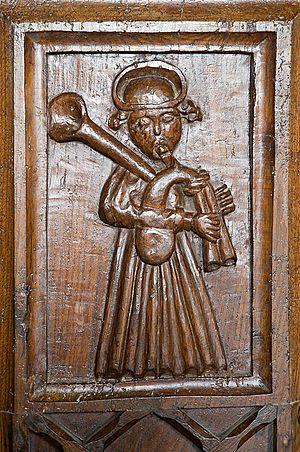Cornish bagpipes facts for kids
Cornish bagpipes (Cornish: Pibow sagh kernewek) are the forms of bagpipes once common in Cornwall in the 19th century. Bagpipes and pipes are mentioned in Cornish documentary sources from c.1150 to 1830 and bagpipes are present in Cornish iconography from the 15th and 16th centuries.
Contents
Late Medieval iconography
Twin-chanter bagpipes appear in late-Medieval iconography in churches at Altarnun, Davidstow, St Austell and Braddock, Cornwall and at Marwood, and Tavistock, Devon. A single chanter bagpipe and other instruments are depicted on the east wall of St Mary's, Launceston, Cornwall (c. 1520-1540). Such images must be considered with care.
The earliest representation, at St. Austell, is a 15th-century gargoyle, unique in Cornwall but still probably a stereotypical image created by the mason. The Davidstow image, perhaps mid- 16th century, and perhaps of an angel, may also be stereotypical. The bagpiping dog of Braddock is a stereotypical image found on European pilgrim brooches and elsewhere. Marwood is a biblical depiction with possibly a generic representation of the bagpipes. However, similar clothing detail at Altarnun and Launceston suggests that those images are indeed representative of local practice in c. 1520-1540. The Tavistock bagpiper looks like those of Altarnun and Launceston, but the carving lacks the detail to permit certainty.
Twin chanter pipes
Iconography of double chanter bagpipes and aulos was common 600 years ago. There are 'clusters' of such images in Yorkshire and Dorset as well as Cornwall. Perhaps remoteness or cultural introspection preserved such instruments in the South West when they died out elsewhere. The Launceston bagpipe has a conical bore chanter, which would give a loud, full tone often associated with outdoor performance. The bagpipe at Altarnun has parallel bore chanters which would give a quieter, reedy tone normally associated with indoor use. The asymmetrical chanters at Altarnun may be representative or a function of perspective. The lengths as now measured would give a pitch difference of about a tone.
Modern Cornish bagpipes and bagpiping
Modern realisations of the two-chanter bagpipe have been created in small numbers since the late 20th century. The double chanter configuration permits interesting harmonies. One chanter plays the upper half of the octave, the other the lower half. Both chanters can play the tonic note and thus, using covered fingering, one can create a constant drone whilst playing the melody. This drone effect is a striking feature of the double chanter bagpipes. Such bagpipes are also good for low, rich accompaniments.
From the 1990s onward, pipemakers like Julian Goodacre have produced a number of Cornish double-pipes. In late 2009 the numbers playing bagpipes based on Cornish iconography was self-evidently small compared to those playing Scottish smallpipes or Northumbrian pipes. Merv Davey of Pyba has done much to explore the possibilities of these instruments. Cornish bagpipes are now played at the Cornish Gorsedh, replacing the brass bands used for processional purposes in the early 20th century.
Historiography
Harry Woodhouse's Cornish Bagpipes: Fact or Fiction? provided an opening discussion of the historical references to piping in Cornwall. James Merryweather responded to this, emphasising that iconography of double chanter bagpipes is not unique to Cornwall, and that the term 'pipes' does not necessarily imply 'bagpipes'. Mike O'Connor revisited the topic emphasising the context provided by various documentary sources and the realistic dress detail at Altarnun and Launceston, which suggests that the images are of retained local musicians and represent Cornish practice of the early 16th century.
Summary
Extensive documentary evidence confirms that piping was a central element in music-making in medieval Cornwall. While some iconography may be stereotypical, dress detail at Altarnun and Launceston suggests the images represent Cornish practice in the early 16th century. This practice involved both double and single chanter bagpipes. Double chanter bagpipes were not unique to Cornwall, but may have survived there longer than in Dorset or Yorkshire, perhaps due to Cornwall's isolation or to local favour. Whilst there is much evidence for bagpipes in late medieval times, the paucity of later reports suggest that Cornish bagpiping was then in decline. The late 20th century saw renewed interest in the history and practice of bagpiping in Cornwall, leading to reconstructions of pipes seen in Cornish iconography and exploration of technique and repertoire.


